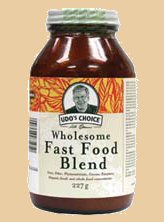|
|

 The
natural fibers found in foods are one of the most overlooked parts
of our nutrient picture. Udo's Choice Wholesome Fast Food Blend
supplies a rich mix of fibers, proteins and essential fats.
not only aiding in regularity
and cleansing the G-I tract, but also supporting vital secondary
functions such as exporting cholesterol and stimulating
enzyme production.
DOWNLOAD
THE PDF FILE ON UDO'S CHOICE™ WHOLESOME FAST FOOD BLEND!
(457k)

In terms
of food, fiber is indigestible material that comes from plants. Nature
made specialized plant cell walls out of fiber precisely to give rigidity
and shape to trees, shrubs, grasses, and herbs. When animals eat plants,
our health benefits by the nutrients they provide, as well as the positive
effects fiber has within the digestive tract.
The fiber composition of plants varies based on plant species but, generally,
all plants contain all kinds of fiber. The 2 main categories are:
- Water-insoluble, including
cellulose, hemicellulose, and lignin; and
- Water-soluble, including
pectin, gums, and mucilage. Water-soluble fiber is considered the
most health-benefiting type of fiber, especially mucilage fiber.
Only foods from plant sources will supply us with fiber necessary
for health
because animal products lack fiber. 
- unprocessed seeds
like flax, psyllium, sesame, sunflower and chia, and nuts (but not
the oils from them);
- wheat, oat, barley,
and rice bran and other whole grains such as brown rice (but not
the white rice or white flour made from them);
- certain vegetables
such as beets, asparagus, broccoli, artichokes, carrots, brussels
sprouts, parsnips, spinach, and yams (excluding one-celled greens);
- mucilaginous herbs
like slippery elm;
- several kinds
of seaweed such as kelp or dulse;
- legumes such as
kidney, lima, pinto, navy and soy beans, chickpeas, lentils, and
peas.
- pectin of some
fruits such as apples, pears, prunes and raspberries; and
- supplements of
concentrated fiber.
Diets deprived of
fiber can be corrected by incorporating more of the fiber-rich foods (such as the ones listed above) into your diet, or by adding fiber supplements
to fiber-poor foods. We use a specially prepared blend of fiber and nutrients
called Udo's Choice Wholesome Fast Food Blend.
By the age of 40, at 3 meals per
day, one person would have eaten almost 44,000 meals. With numbers
like this, efficient passing of food through our system becomes a valuable
asset to our health.
- Delays gastric emptying time
and the absorption of nutrients from the small intestine;
- Sweeps our digestive tract;
- Bulks stools;
- Accelerates colonic transit
time;
- Alleviates constipation; and
- Promotes colon health.
In addition to
the same benefits as are provided by insoluble fiber, (especially the mucilage type of soluble fiber)
also:
- Escorts cholesterol and triglycerides
out of the body and inhibits their production in the liver;
- Assists with the elimination
of toxins, and heavy metals in the body;
- Stimulates pancreatic enzyme
release and activity;
- Stabilizes blood glucose by
slowing down glucose absorption;
- Aids in weight loss by providing
a feeling of fullness and reducing calorie absorption;
- Improves bowel regularity
by absorbing water;
- Significantly increases colonic
transit time;
- Eases irritable bowel syndrome
(IBS) in some cases;
- Soothes our intestines; and
- Reduces risk of colon cancer.

The most important point to make is simply
that fiber needs to be present
in optimum quantities in our food supply. Research
suggests that 35-50 grams (1-2 ounces) per day brings optimum bowel
health for
adults, but the average American only gets about 12 grams per day.
vegetable juices, oatmeal,
porridge, yogurt, apple sauce, or soups and can be sprinkled onto virtually any
food. Add greens, digestive enzymes, essential fats, protein powder, yogurt and
lots of water to the Fast Food Blend, and turn it into a blended shake. It is
delicious, nutritious, and will fill you up for hours. Water-soluble fiber will
thicken liquids, so adding extra water to recipes is advised.
During times of hunger, or low
blood sugar (and the mood swings, tiredness, double vision, and/or
shakiness that go with low blood sugar), simply put 2 Tbsp. of Udo's
Choice Wholesome Fast Food Blend in an 8oz. glass of water and drink.
The low blood sugar blues disappear quickly.
Because the Wholesome Fast Food Blend is made from whole foods, it is still perishable.
Once the bottle has been opened, it must be placed back in the fridge and used
within 3 months for supreme freshness.
 Fiber is used for easing both constipation
and chronic diarrhea. However,
in some cases, fiber could aggravate diarrhea, so it is recommended to reduce
your
dietary fiber intake or refrain from ingesting more fiber until symptoms have
disappeared. Visit your naturopathic physician before making any dietary changes. Fiber is used for easing both constipation
and chronic diarrhea. However,
in some cases, fiber could aggravate diarrhea, so it is recommended to reduce
your
dietary fiber intake or refrain from ingesting more fiber until symptoms have
disappeared. Visit your naturopathic physician before making any dietary changes.
Udo's Choice™ Wholesome Fast Food Blend provides more than just
fiber. It is a blend of 50 different ingredients including whole
food concentrates, vegetables, and phytonutrient-rich herbs. The
constituents
of this unique formula are of the finest quality, all natural,
and primarily organic. Hints of cinnamon and almond add to the
flavor. Its ingredients include:
- Over 35% fiber;
- Approximately 20% proteins;
- Approximately 15% essential
fats;
- Very little carbohydrate;
- Small amounts of greens and
herbs;
References:
- Trowell H, Burkitt D, and
Heaton K, Dietary Fibre, Fibre-depleted Foods and Disease.
Academic Press, New York, NY, 1985.
- Trowell H, and Burkitt D, Western
Diseases: Their Emergence and Prevention. Harvard University
Press, Boston, MA, 1985.
- Kamen, Betty, New Facts
about Fiber. Nutrition Encounter Inc., 1991.
- Murray, Michael T., Encyclopedia
of Nutritional Supplements. Prima Publishing, 1996.
- Frederick, Carlton, High-Fiber
Way to Total Health. Pocket Books, New York, 1976.
- Wardlaw, Gordon M., Perspectives
in Nutrition. McGraw-Hill, 1999.
- Spiller, GA, Dietary Fiber
in Health and Nutrition. CRC Press, Boca Raton, FL, 1994.
- Cunnane S.C., et al., High
alpha-linolenic acid flaxseed (Linum usitatissimum): some nutritional
properties in humans. Br J Nutr 1993 Mar;69(2):443-53. Department
of Nutritional Sciences, Faculty of Medicine, University of Toronto,
Canada.
- Anderson J.W., et al., Effects
of psyllium on glucose and serum lipid responses in men with type
2 diabetes and hypercholesterolemia. Am J Clin Nutr 1999 Oct;70(4):466-73.
Veterans Affairs Medical Center, the University of Kentucky, Lexington
40511, USA.
- Kestin M., et al., Comparative
effects of three cereal brans on plasma lipids, blood pressure, and
glucose metabolism in mildly hypercholesterolemic men. Am J Clin
Nutr 1990 Oct;52(4):661-6. CSIRO Division of Human Nutrition,
Adelaide, Australia.
- Bennett W.G., Cerda J.J.,
Benefits of dietary fiber. Myth or medicine? Postgrad Med 1996
Feb;99(2):153-6, 166-8, 171-2 passim. Division of Gastroenterology,
University of Florida, Gainesville 32610-0214 USA.
- Anderson J.W., Smith B.M.,
Gustafson N.J., Health benefits and practical aspects of high-fiber
diets. Am J Clin Nutr 1994 May;59(5 Suppl):1242S-1247S. Medical
Services, Veterans' Affairs Medical Center, Lexington, KY 40511.
- Chen H.L., Mechanisms by which
wheat bran and oat bran increase stool weight in humans. Am J
Clin Nutr 1998 Sep;68(3):711-9. Department of Nutritional Sciences,
University of Wisconsin-Madison, 53706, USA.
- Whyte J.L., et al., Oat bran
lowers plasma cholesterol levels in mildly hypercholesterolemic men. J
Am Diet Assoc 1992 Apr;92(4):446-9. Department of Nutrition,
School of Public Health, University of North Carolina.
- Anderson J.W., Hanna T.J.,
Impact of nondigestible carbohydrates on serum lipoproteins and risk
for cardiovascular disease. J Nutr 1999 Jul;129(7 Suppl):1457S-66S.
Metabolic Research Group, VA Medical Center and University of Kentucky,
Lexington, KY, USA.
- Le Marchand L., et al., Dietary
fiber and colorectal cancer risk. Epidemiology 1997 Nov;8(6):658-65.
Etiology Program, University of Hawaii Cancer Research Center, Honolulu,
USA.
- De Stefani E., et al., Dietary
fiber and risk of breast cancer: a case-control study in Uruguay. Nutr
Cancer 1997;28(1):14-9. Registro Nacional de Cancer, Montevideo,
Uruguay.
- Gray D.S., The clinical uses
of dietary fiber. Am Fam Physician 1995 Feb 1;51(2):419-26.
Community Hospital Family Practice Residency, Santa Rosa, California.
- Stoll Ba., Diet and exercise
regimens to improve breast carcinoma prognosis. Cancer 1996
Dec 15;78(12):2465-70. Oncology Department, St. Thomas' Hospital,
London, United Kingdom.
- Kimm S.Y., The role of dietary
fiber in the development and treatment of childhood obesity. Pediatrics 1995
Nov;96(5 Pt 2):1010-4. Department of Family Medicine and Clinical
Epidemiology, School of Medicine, University of Pittsburgh, USA.
- Kaul L., Nidiry J., High-fiber
diet in the treatment of obesity and hypercholesterolemia. J Natl
Med Assoc 1993 Mar;85(3):231-2. Department of Community Health
and Family Practice, Howard University College of Medicine, Washington,
DC 20059.
- Weisburger J.H., et al., Protective
mechanisms of dietary fibers in nutritional carcinogenesis. Basic
Life Sci 1993;61:45-63. American Health Foundation, Valhalla,
New York 10595-1599.
- Anderson J.W., Dietary fiber,
lipids and atherosclerosis. Am J Cardiol 1987 Oct 30;60(12):17G-22G.
Medical Service, Veterans Administration Medical Center, Lexington,
Kentucky 40511.
- Kay R.M., Effects of dietary
fibre on serum lipid levels and fecal bile acid excretion. Can
Med Assoc J 1980 Dec 20;123(12):1213-7.
- Rigaud D., et al., Effect
of psyllium on gastric emptying, hunger feeling and food intake in
normal volunteers: a double blind study. Eur J Clin Nutr 1998
Apr;52(4):239-45. Service de Gastroenterologie et Nutrition, Hopital
Bichat, Paris, France.
|



